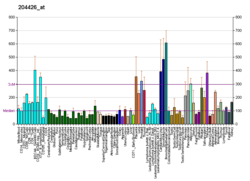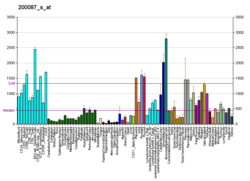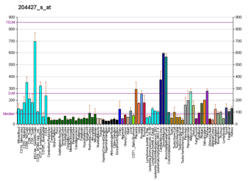TMED2
Transmembrane emp24 domain-containing protein 2 is a protein that in humans is encoded by the TMED2 gene.[5][6]
Interactions
TMED2 has been shown to interact with GORASP1[7] and GORASP2.[7]
References
- 1 2 3 GRCh38: Ensembl release 89: ENSG00000086598 - Ensembl, May 2017
- 1 2 3 GRCm38: Ensembl release 89: ENSMUSG00000029390 - Ensembl, May 2017
- ↑ "Human PubMed Reference:".
- ↑ "Mouse PubMed Reference:".
- ↑ Blum R, Feick P, Puype M, Vandekerckhove J, Klengel R, Nastainczyk W, Schulz I (September 1996). "Tmp21 and p24A, two type I proteins enriched in pancreatic microsomal membranes, are members of a protein family involved in vesicular trafficking". J Biol Chem. 271 (29): 17183–9. PMID 8663407. doi:10.1074/jbc.271.29.17183.
- ↑ "Entrez Gene: TMED2 transmembrane emp24 domain trafficking protein 2".
- 1 2 Barr, F A; Preisinger C; Kopajtich R; Körner R (Dec 2001). "Golgi matrix proteins interact with p24 cargo receptors and aid their efficient retention in the Golgi apparatus". J. Cell Biol. United States. 155 (6): 885–91. ISSN 0021-9525. PMC 2150891
 . PMID 11739402. doi:10.1083/jcb.200108102.
. PMID 11739402. doi:10.1083/jcb.200108102.
Further reading
- Fiedler K, Veit M, Stamnes MA, Rothman JE (1996). "Bimodal interaction of coatomer with the p24 family of putative cargo receptors.". Science. 273 (5280): 1396–9. PMID 8703076. doi:10.1126/science.273.5280.1396.
- Gommel D, Orci L, Emig EM, et al. (1999). "p24 and p23, the major transmembrane proteins of COPI-coated transport vesicles, form hetero-oligomeric complexes and cycle between the organelles of the early secretory pathway.". FEBS Lett. 447 (2–3): 179–85. PMID 10214941. doi:10.1016/S0014-5793(99)00246-X.
- Majoul I, Straub M, Hell SW, et al. (2001). "KDEL-cargo regulates interactions between proteins involved in COPI vesicle traffic: measurements in living cells using FRET". Dev. Cell. 1 (1): 139–53. PMID 11703931. doi:10.1016/S1534-5807(01)00004-1.
- Barr FA, Preisinger C, Kopajtich R, Körner R (2002). "Golgi matrix proteins interact with p24 cargo receptors and aid their efficient retention in the Golgi apparatus". J. Cell Biol. 155 (6): 885–91. PMC 2150891
 . PMID 11739402. doi:10.1083/jcb.200108102.
. PMID 11739402. doi:10.1083/jcb.200108102. - Strausberg RL, Feingold EA, Grouse LH, et al. (2003). "Generation and initial analysis of more than 15,000 full-length human and mouse cDNA sequences". Proc. Natl. Acad. Sci. U.S.A. 99 (26): 16899–903. PMC 139241
 . PMID 12477932. doi:10.1073/pnas.242603899.
. PMID 12477932. doi:10.1073/pnas.242603899. - Breuza L, Halbeisen R, Jenö P, et al. (2004). "Proteomics of endoplasmic reticulum-Golgi intermediate compartment (ERGIC) membranes from brefeldin A-treated HepG2 cells identifies ERGIC-32, a new cycling protein that interacts with human Erv46". J. Biol. Chem. 279 (45): 47242–53. PMID 15308636. doi:10.1074/jbc.M406644200.
- Gerhard DS, Wagner L, Feingold EA, et al. (2004). "The status, quality, and expansion of the NIH full-length cDNA project: the Mammalian Gene Collection (MGC)". Genome Res. 14 (10B): 2121–7. PMC 528928
 . PMID 15489334. doi:10.1101/gr.2596504.
. PMID 15489334. doi:10.1101/gr.2596504. - Chen F, Hasegawa H, Schmitt-Ulms G, et al. (2006). "TMP21 is a presenilin complex component that modulates gamma-secretase but not epsilon-secretase activity". Nature. 440 (7088): 1208–12. PMID 16641999. doi:10.1038/nature04667.
- Luo W, Wang Y, Reiser G (2007). "p24A, a type I transmembrane protein, controls ARF1-dependent resensitization of protease-activated receptor-2 by influence on receptor trafficking". J. Biol. Chem. 282 (41): 30246–55. PMID 17693410. doi:10.1074/jbc.M703205200.
This article is issued from
Wikipedia.
The text is licensed under Creative Commons - Attribution - Sharealike.
Additional terms may apply for the media files.






